2014 NISSAN PATHFINDER warning
[x] Cancel search: warningPage 473 of 492
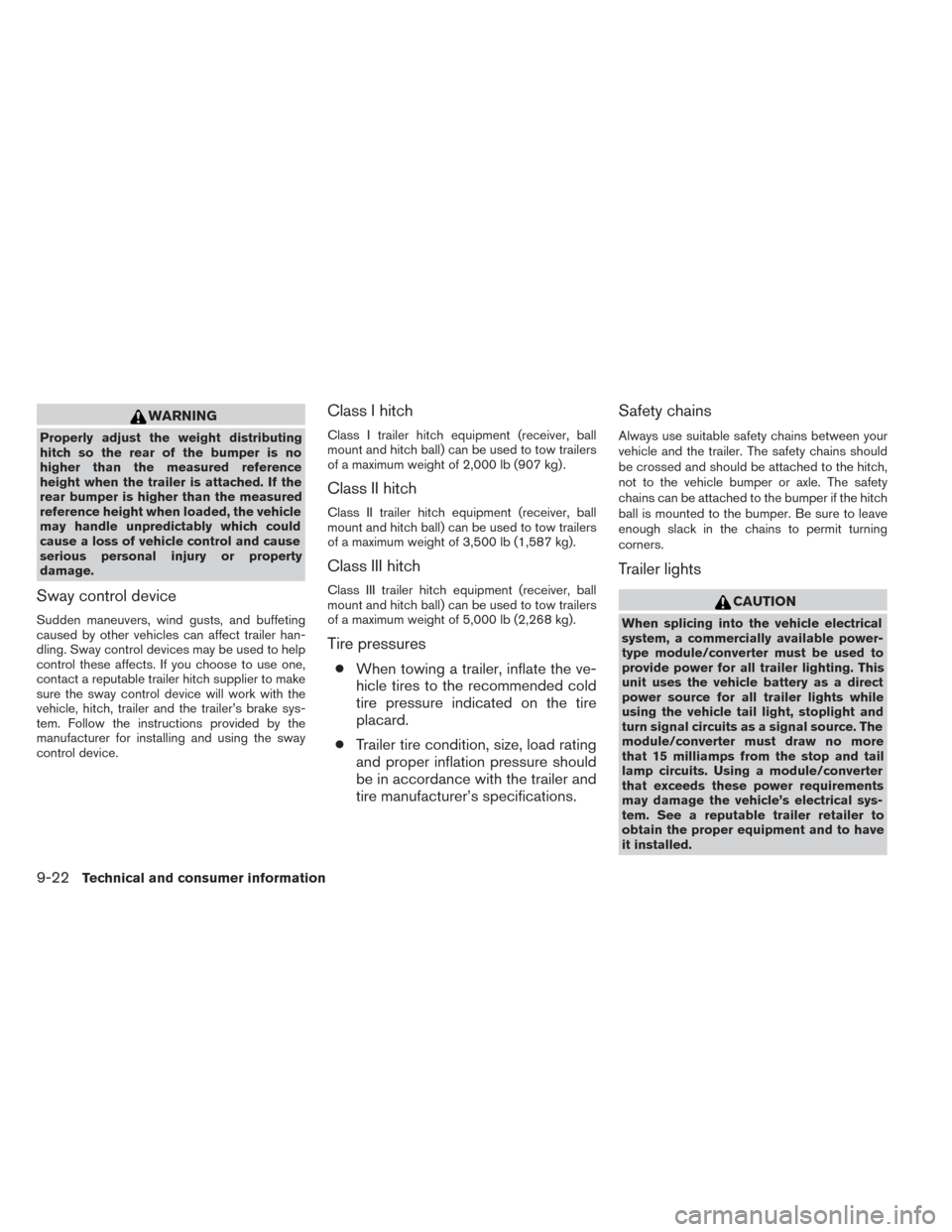
WARNING
Properly adjust the weight distributing
hitch so the rear of the bumper is no
higher than the measured reference
height when the trailer is attached. If the
rear bumper is higher than the measured
reference height when loaded, the vehicle
may handle unpredictably which could
cause a loss of vehicle control and cause
serious personal injury or property
damage.
Sway control device
Sudden maneuvers, wind gusts, and buffeting
caused by other vehicles can affect trailer han-
dling. Sway control devices may be used to help
control these affects. If you choose to use one,
contact a reputable trailer hitch supplier to make
sure the sway control device will work with the
vehicle, hitch, trailer and the trailer’s brake sys-
tem. Follow the instructions provided by the
manufacturer for installing and using the sway
control device.
Class I hitch
Class I trailer hitch equipment (receiver, ball
mount and hitch ball) can be used to tow trailers
of a maximum weight of 2,000 lb (907 kg) .
Class II hitch
Class II trailer hitch equipment (receiver, ball
mount and hitch ball) can be used to tow trailers
of a maximum weight of 3,500 lb (1,587 kg).
Class III hitch
Class III trailer hitch equipment (receiver, ball
mount and hitch ball) can be used to tow trailers
of a maximum weight of 5,000 lb (2,268 kg).
Tire pressures
●When towing a trailer, inflate the ve-
hicle tires to the recommended cold
tire pressure indicated on the tire
placard.
● Trailer tire condition, size, load rating
and proper inflation pressure should
be in accordance with the trailer and
tire manufacturer’s specifications.
Safety chains
Always use suitable safety chains between your
vehicle and the trailer. The safety chains should
be crossed and should be attached to the hitch,
not to the vehicle bumper or axle. The safety
chains can be attached to the bumper if the hitch
ball is mounted to the bumper. Be sure to leave
enough slack in the chains to permit turning
corners.
Trailer lights
CAUTION
When splicing into the vehicle electrical
system, a commercially available power-
type module/converter must be used to
provide power for all trailer lighting. This
unit uses the vehicle battery as a direct
power source for all trailer lights while
using the vehicle tail light, stoplight and
turn signal circuits as a signal source. The
module/converter must draw no more
that 15 milliamps from the stop and tail
lamp circuits. Using a module/converter
that exceeds these power requirements
may damage the vehicle’s electrical sys-
tem. See a reputable trailer retailer to
obtain the proper equipment and to have
it installed.
9-22Technical and consumer information
Page 474 of 492

Trailer lights should comply with federal and/or
local regulations. For assistance in hooking up
trailer lights, contact a NISSAN dealer or repu-
table trailer retailer. Vehicles equipped with the
optional trailer tow package are equipped with a
7-pin trailer harness connector. If your trailer is
equipped with a flat 4-pin connector, an adapter
will be needed to connect the trailer lights to the
vehicle. Adapters are available at auto parts
stores and hitch retailers.
Trailer brakes
When towing a trailer load of 3,500 lbs.
(1,587 kg) or more, trailers with a brake
system MUST be used.However, most states
require a separate braking system on trailers with
a loaded weight above a specific amount. Make
sure the trailer meets the local regulations and
the regulations where you plan to tow.
Several types of braking systems are available.
Surge Brakes -The surge brake actuator is
mounted on the trailer tongue with a hydraulic line
running to each trailer wheel. Surge brakes are
activated by the trailer pushing against the hitch
ball when the tow vehicle is braking. Hydraulic
surge brakes are common on rental trailers and
some boat trailers. In this type of system, there is
no hydraulic or electric connection for brake op-
eration between the tow vehicle and the trailer. Electric Trailer Brakes -Electric braking sys-
tems are activated by an electronic signal sent
from a trailer brake controller (special brake-
sensing module) . If electric trailer brakes are
used, see “Electric trailer brake controller” in this
section.
Have a professional supplier of towing equip-
ment make sure the trailer brakes are properly
installed and demonstrate proper brake function
testing.
WARNING
Never connect a trailer brake system di-
rectly to the vehicle brake system.
Electric trailer brake controller
Trailers equipped with electric brakes may re-
quire the installation of an aftermarket trailer
brake controller.
Your vehicle is equipped with a connector and
jumper harness that is specifically designed to be
used when installing an aftermarket brake con-
troller.
To install the electric trailer brake controller jumper
harness, perform the following procedure:
1. Open the driver door. Move the seat to the
rearmost position.
example
LTI0117
Technical and consumer information9-23
Page 479 of 492
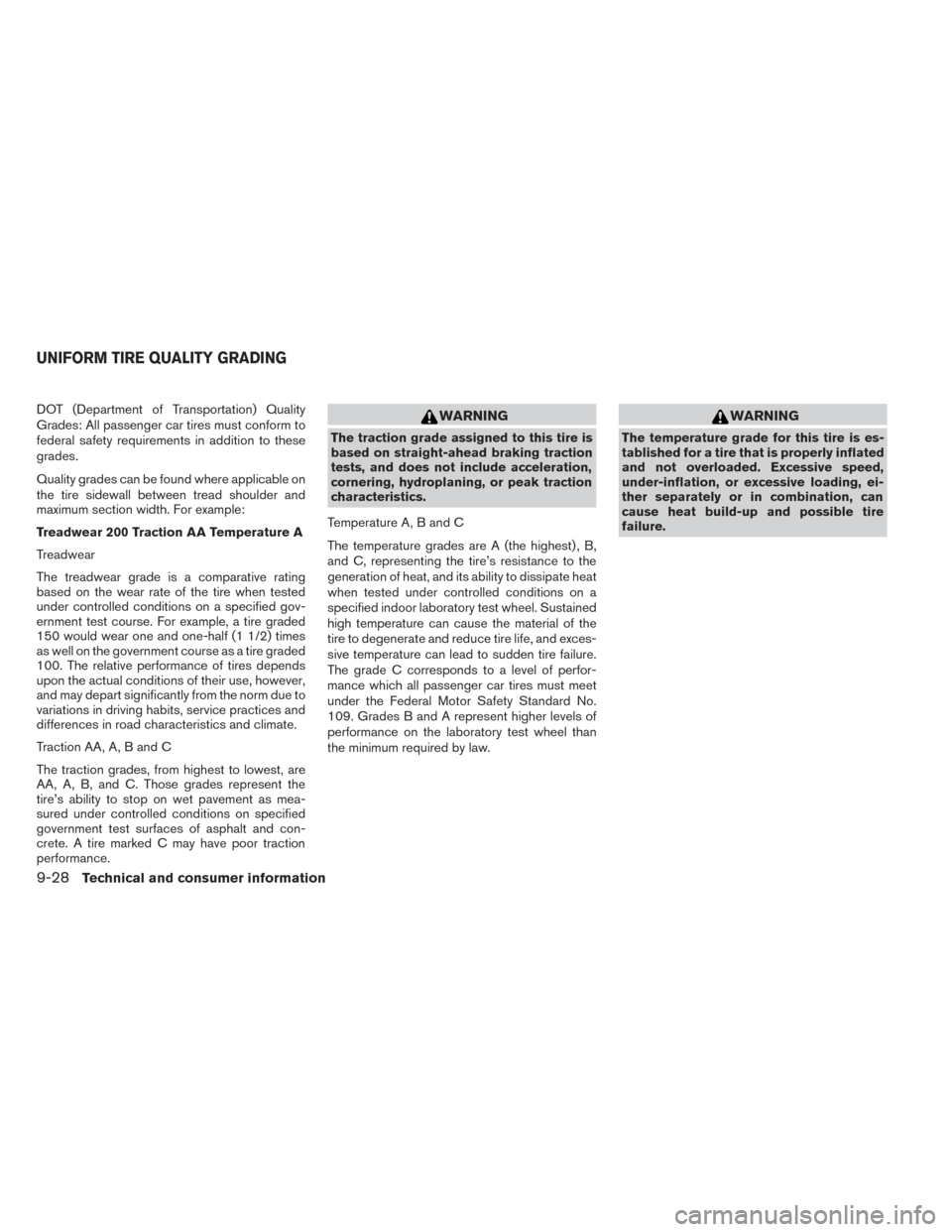
DOT (Department of Transportation) Quality
Grades: All passenger car tires must conform to
federal safety requirements in addition to these
grades.
Quality grades can be found where applicable on
the tire sidewall between tread shoulder and
maximum section width. For example:
Treadwear 200 Traction AA Temperature A
Treadwear
The treadwear grade is a comparative rating
based on the wear rate of the tire when tested
under controlled conditions on a specified gov-
ernment test course. For example, a tire graded
150 would wear one and one-half (1 1/2) times
as well on the government course as a tire graded
100. The relative performance of tires depends
upon the actual conditions of their use, however,
and may depart significantly from the norm due to
variations in driving habits, service practices and
differences in road characteristics and climate.
Traction AA, A, B and C
The traction grades, from highest to lowest, are
AA, A, B, and C. Those grades represent the
tire’s ability to stop on wet pavement as mea-
sured under controlled conditions on specified
government test surfaces of asphalt and con-
crete. A tire marked C may have poor traction
performance.WARNING
The traction grade assigned to this tire is
based on straight-ahead braking traction
tests, and does not include acceleration,
cornering, hydroplaning, or peak traction
characteristics.
Temperature A, B and C
The temperature grades are A (the highest) , B,
and C, representing the tire’s resistance to the
generation of heat, and its ability to dissipate heat
when tested under controlled conditions on a
specified indoor laboratory test wheel. Sustained
high temperature can cause the material of the
tire to degenerate and reduce tire life, and exces-
sive temperature can lead to sudden tire failure.
The grade C corresponds to a level of perfor-
mance which all passenger car tires must meet
under the Federal Motor Safety Standard No.
109. Grades B and A represent higher levels of
performance on the laboratory test wheel than
the minimum required by law.
WARNING
The temperature grade for this tire is es-
tablished for a tire that is properly inflated
and not overloaded. Excessive speed,
under-inflation, or excessive loading, ei-
ther separately or in combination, can
cause heat build-up and possible tire
failure.
UNIFORM TIRE QUALITY GRADING
9-28Technical and consumer information
Page 481 of 492
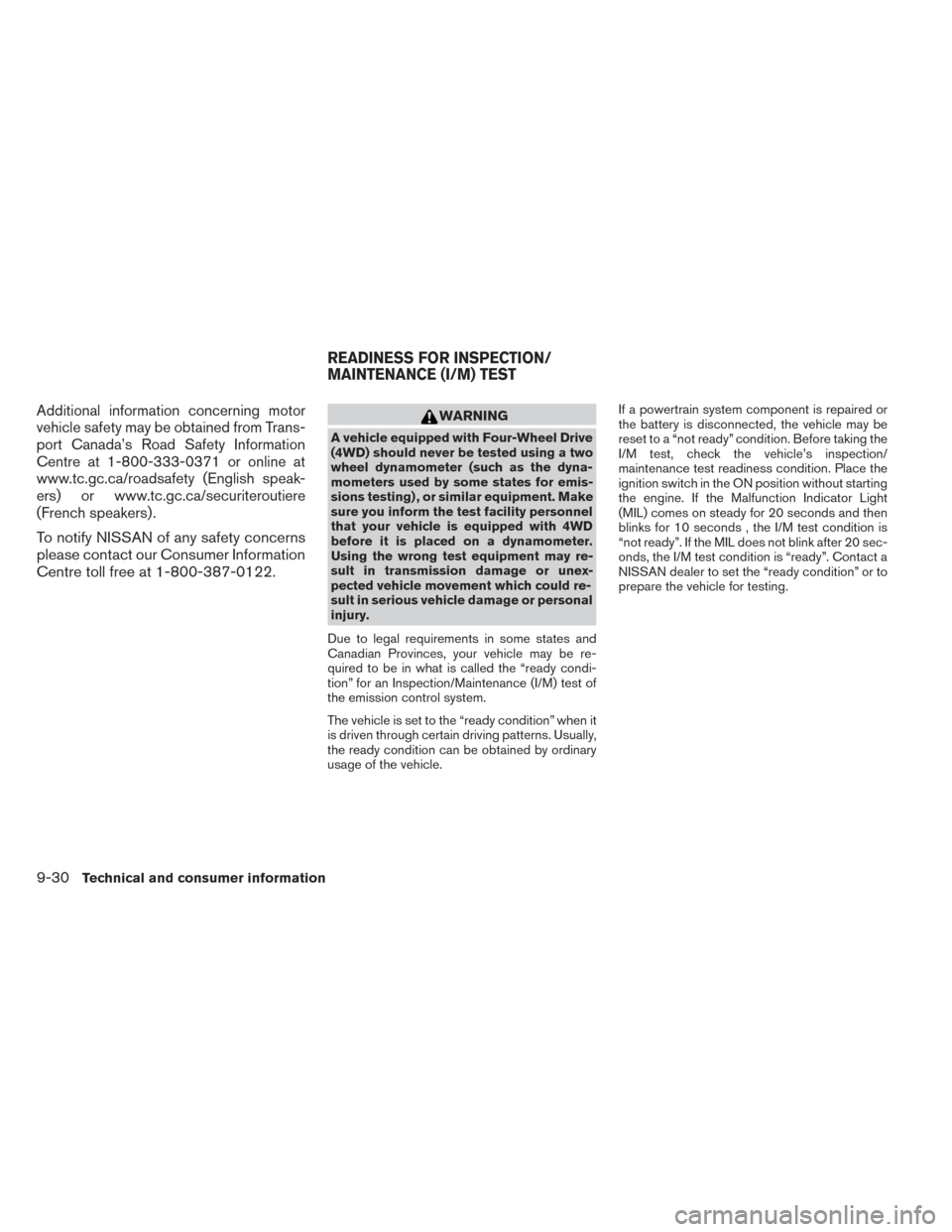
Additional information concerning motor
vehicle safety may be obtained from Trans-
port Canada’s Road Safety Information
Centre at 1-800-333-0371 or online at
www.tc.gc.ca/roadsafety (English speak-
ers) or www.tc.gc.ca/securiteroutiere
(French speakers) .
To notify NISSAN of any safety concerns
please contact our Consumer Information
Centre toll free at 1-800-387-0122.
WARNING
A vehicle equipped with Four-Wheel Drive
(4WD) should never be tested using a two
wheel dynamometer (such as the dyna-
mometers used by some states for emis-
sions testing) , or similar equipment. Make
sure you inform the test facility personnel
that your vehicle is equipped with 4WD
before it is placed on a dynamometer.
Using the wrong test equipment may re-
sult in transmission damage or unex-
pected vehicle movement which could re-
sult in serious vehicle damage or personal
injury.
Due to legal requirements in some states and
Canadian Provinces, your vehicle may be re-
quired to be in what is called the “ready condi-
tion” for an Inspection/Maintenance (I/M) test of
the emission control system.
The vehicle is set to the “ready condition” when it
is driven through certain driving patterns. Usually,
the ready condition can be obtained by ordinary
usage of the vehicle. If a powertrain system component is repaired or
the battery is disconnected, the vehicle may be
reset to a “not ready” condition. Before taking the
I/M test, check the vehicle’s inspection/
maintenance test readiness condition. Place the
ignition switch in the ON position without starting
the engine. If the Malfunction Indicator Light
(MIL) comes on steady for 20 seconds and then
blinks for 10 seconds , the I/M test condition is
“not ready”. If the MIL does not blink after 20 sec-
onds, the I/M test condition is “ready”. Contact a
NISSAN dealer to set the “ready condition” or to
prepare the vehicle for testing.
READINESS FOR INSPECTION/
MAINTENANCE (I/M) TEST
9-30Technical and consumer information
Page 484 of 492

10 Index
A
Air bag (See supplemental restraint
system) .....................1-53
Air bag system Front (See supplemental front impact
air bag system) ...............1-60
Airbagwarninglabels.............1-68
Airbagwarninglight...........1-68,2-14
Air cleaner housing filter ............8-18
Air conditioner Air conditioner service ...........4-49
Air conditioner specification label .....9-11
Air conditioner system refrigerant and
oil recommendations .............9-6
Heater and air conditioner
controls................4-41,4-45
Rear seat air conditioner ..........4-43
Servicing air conditioner ..........4-49
Alarm system
(See vehicle security system) .........2-26
Anchor point locations .............1-38
Antenna....................4-104
Anti-lock brake warning light ..........2-10
Anti-lock Braking System (ABS) ........5-28
Audible reminders ...............2-16
Audio system ..................4-49
Bluetooth®audio..............4-99
Compact Disc (CD) changer .......4-67
Compact disc (CD) player .....4-74,4-81
FM-AM radio with compact disc
(CD) changer ................4-65 FM/AM/SAT radio with CD/DVD player . .4-77
FM/AM/SAT radio with compact disc
(CD) player
.................4-70
Audio System iPod®Player.............4-93,4-95
Audio system Radio ....................4-49
Steering wheel audio control switch . . .4-103
USB interface ............4-88,4-90
Autolight switch .................2-32
Automatic Automatic drive positioner .........3-35
Automatic power window switch .....2-52
Automatic anti-glare inside mirror .......3-32
Automatic door locks ..............3-6
AUXjack ....................4-69
B
Battery ......................8-14
Charge warning light ............2-11
Before starting the engine ...........5-13
Belt (See drive belt) ..............8-16
Block heater Engine ....................5-34
Bluetooth®audio................4-99
Bluetooth® hands-free phone
system .................4- 118, 4-131
Boosterseats..................1-50
Brake Anti-lock Braking System (ABS) ......5-28
Brake fluid ..................8-12 Brakelight(Seestoplight).........8-26
Brake system
................5-27
Brake warning light .............2-11
Brake wear indicators ........2-16,8-20
Parking brake operation ..........5-18
Self-adjusting brakes ............8-20
Brakes ......................8-20
Break-inschedule ...............5-21
Brightness/contrast button .......4-11,4-20
Brightness control Instrument panel ..............2-34
Bulb check/instrument panel ..........2-10
Bulbreplacement................8-26
C
Capacities and recommended
fuel/lubricants ...................9-2
Cargolight ...................2-57
Cargo
(See vehicle loading information) . . .9-12
Car phone or CB radio ............4-117
CD care and cleaning .............4-102
CD changer (See audio system) .......4-67
CD player (See audio system) .....4-74,4-81
Check tire pressure ...............2-25
Child restraints .......1-31,1-32,1-33,1-35
Precautions on child
restraints ........1-33,1-40,1-45,1-50
Top tether strap anchor point locations . .1-38
Child restraint with top tether strap ......1-37
Child safety rear door lock ............3-7
Chimes,audiblereminders...........2-16
Page 485 of 492
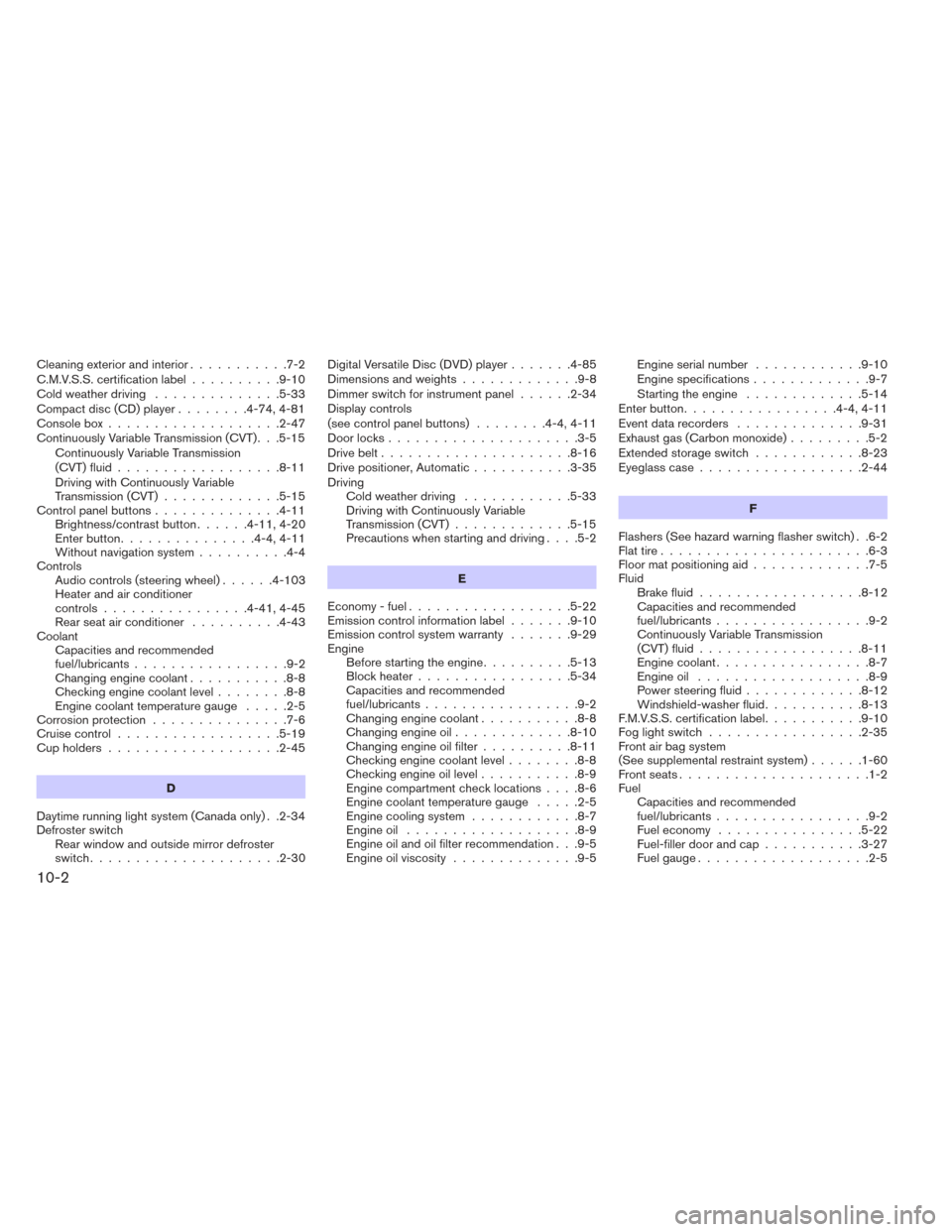
Cleaning exterior and interior...........7-2
C.M.V.S.S. certification label ..........9-10
Cold weather driving ..............5-33
Compact disc (CD) player ........4-74,4-81
Consolebox...................2-47
Continuously Variable Transmission (CVT). . .5-15 Continuously Variable Transmission
(CVT) fluid ..................8-11
Driving with Continuously Variable
Transmission (CVT) .............5-15
Control panel buttons ..............4-11
Brightness/contrast button ......4-11,4-20
Enterbutton...............4-4,4-11
Without navigation system ..........4-4
Controls Audiocontrols(steeringwheel)......4-103
Heater and air conditioner
controls ................4-41,4-45
Rear seat air conditioner ..........4-43
Coolant Capacities and recommended
fuel/lubricants .................9-2
Changing engine coolant ...........8-8
Checking engine coolant level ........8-8
Engine coolant temperature gauge .....2-5
Corrosionprotection ...............7-6
Cruisecontrol..................5-19
Cupholders...................2-45
D
Daytime running light system (Canada only) . .2-34
Defroster switch Rear window and outside mirror defroster
switch.....................2-30 Digital Versatile Disc (DVD) player
.......4-85
Dimensionsandweights.............9-8
Dimmer switch for instrument panel ......2-34
Display controls
(seecontrolpanelbuttons) ........4-4,4-11
Door locks .....................3-5
Drive belt .....................8-16
Drive positioner, Automatic ...........3-35
Driving Cold weather driving ............5-33
Driving with Continuously Variable
Transmission (CVT) .............5-15
Precautions when starting and driving ....5-2
E
Economy - fuel ..................5-22
Emission control information label .......9-10
Emission control system warranty .......9-29
Engine Before starting the engine ..........5-13
Block heater .................5-34
Capacities and recommended
fuel/lubricants .................9-2
Changingenginecoolant...........8-8
Changingengineoil.............8-10
Changing engine oil filter ..........8-11
Checking engine coolant level ........8-8
Checking engine oil level ...........8-9
Engine compartment check locations ....8-6
Engine coolant temperature gauge .....2-5
Engine cooling system ............8-7
Engineoil ...................8-9
Engine oil and oil filter recommendation . . .9-5
Engine oil viscosity ..............9-5 Engine serial number
............9-10
Engine specifications .............9-7
Starting the engine .............5-14
Enterbutton.................4-4,4-11
Eventdatarecorders ..............9-31
Exhaustgas(Carbonmonoxide).........5-2
Extended storage switch ............8-23
Eyeglass case ..................2-44
F
Flashers (See hazard warning flasher switch) . .6-2
Flat tire .......................6-3
Floor mat positioning aid .............7-5
Fluid Brake fluid ..................
8-12
Capacities and recommended
fuel/lubricants .................9-2
Continuously Variable Transmission
(CVT) fluid ..................8-11
Engine coolant .................8-7
Engine oil ...................8-9
Power steering fluid .............8-12
Windshield-washer fluid ...........8-13
F.M.V.S.S. certification label ...........9-10
Foglightswitch .................2-35
Front air bag system
(See supplemental restraint system) ......1-60
Front seats .....................1-2
Fuel Capacities and recommended
fuel/lubricants .................9-2
Fuel economy ................5-22
Fuel-filler door and cap ...........3-27
Fuelgauge...................2-5
10-2
Page 486 of 492
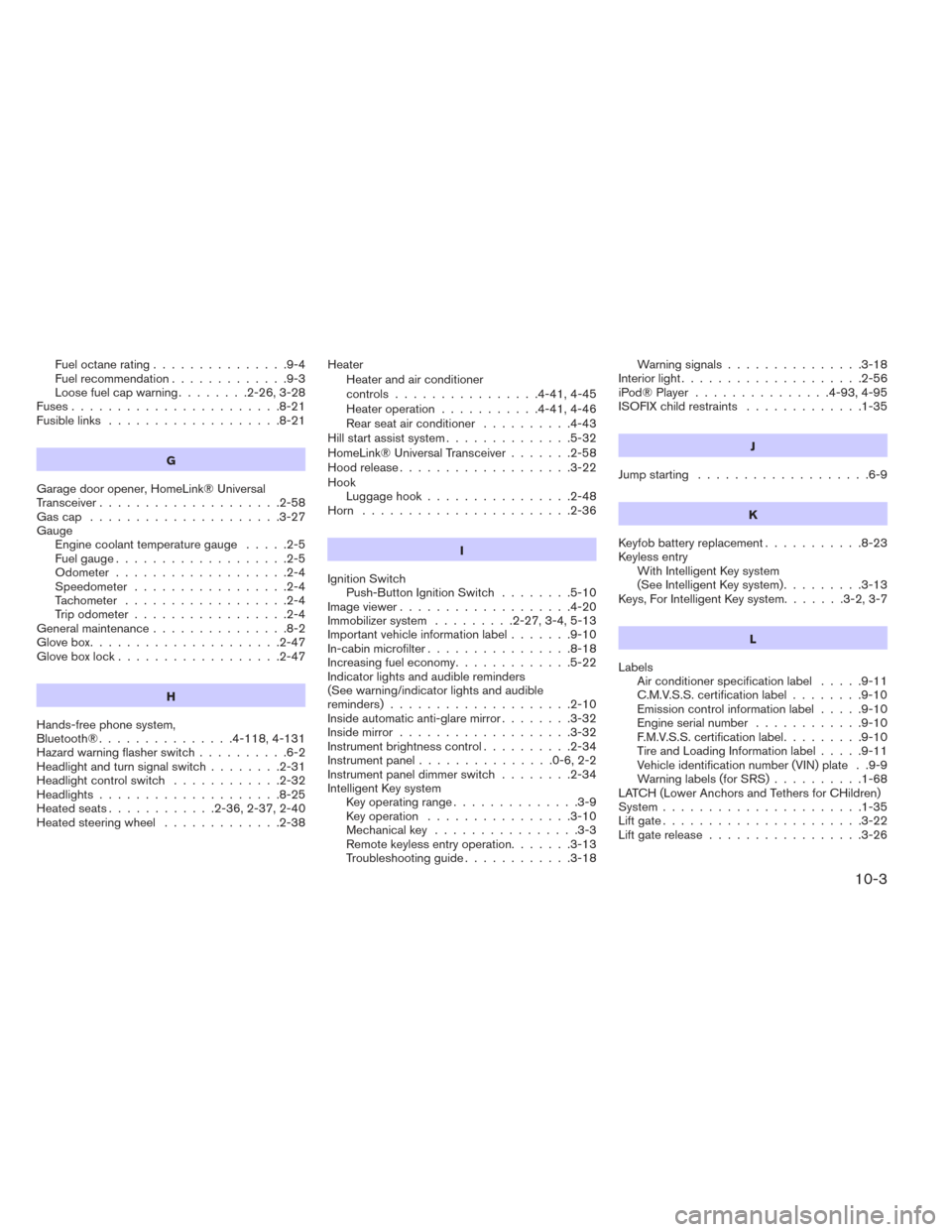
Fueloctanerating...............9-4
Fuel recommendation.............9-3
Loosefuelcapwarning........2-26,3-28
Fuses.......................8-21
Fusiblelinks ...................8-21
G
Garage door opener, HomeLink® Universal
Transceiver....................2-58
Gascap .....................3-27
Gauge Engine coolant temperature gauge .....2-5
Fuel gauge ...................2-5
Odometer ...................2-4
Speedometer .................2-4
Tachometer ..................2-4
Trip odometer .................2-4
Generalmaintenance...............8-2
Glovebox.....................2-47
Gloveboxlock..................2-47
H
Hands-free phone system,
Bluetooth®...............4- 118, 4-131
Hazard warning flasher switch ..........6-2
Headlightandturnsignalswitch........2-31
Headlightcontrolswitch ............2-32
Headlights....................8-25
Heated seats ............2-36,2-37,2-40
Heated steering wheel .............2-38 Heater
Heater and air conditioner
controls................4-41,4-45
Heater operation ...........4-41,4-46
Rear seat air conditioner ..........4-43
Hill start assist system ..............5-32
HomeLink® Universal Transceiver .......2-58
Hood release ...................3-22
Hook Luggagehook................2-48
Horn .......................2-36
I
Ignition Switch Push-Button Ignition Switch ........5-10
Image viewer ...................4-20
Immobilizer system .........2-27,3-4,5-13
Important vehicle information label .......9-10
In-cabin microfilter ................8-18
Increasing fuel economy .............5-22
Indicator lights and audible reminders
(See warning/indicator lights and audible
reminders)....................2-10
Inside automatic anti-glare mirror ........3-32
Inside mirror ...................3-32
Instrument brightness control ..........2-34
Instrument panel ...............0-6,2-2
Instrument panel dimmer switch ........2-34
Intelligent Key system Key operating range ..............3-9
Key operation ................3-10
Mechanicalkey ................3-3
Remote keyless entry operation .......3-13
Troubleshooting guide ............3-18 Warning signals
...............3-18
Interiorlight....................2-56
iPod® Player ...............4-93,4-95
ISOFIX child restraints .............1-35
J
Jump starting ...................6-9
K
Keyfob battery replacement ...........8-23
Keyless entry With Intelligent Key system
(See Intelligent Key system) .........3-13
Keys, For Intelligent Key system .......3-2,3-7
L
Labels Air conditioner specification label .....9-11
C.M.V.S.S. certification label ........9-10
Emission control information label .....
9-10
Engine serial number ............9-10
F.M.V.S.S. certification label .........9-10
Tire and Loading Information label .....9-11
Vehicle identification number (VIN) plate . .9-9
Warning labels (for SRS) ..........1-68
LATCH (Lower Anchors and Tethers for CHildren)
System ......................1-35
Liftgate......................3-22
Lift gate release .................3-26
10-3
Page 487 of 492
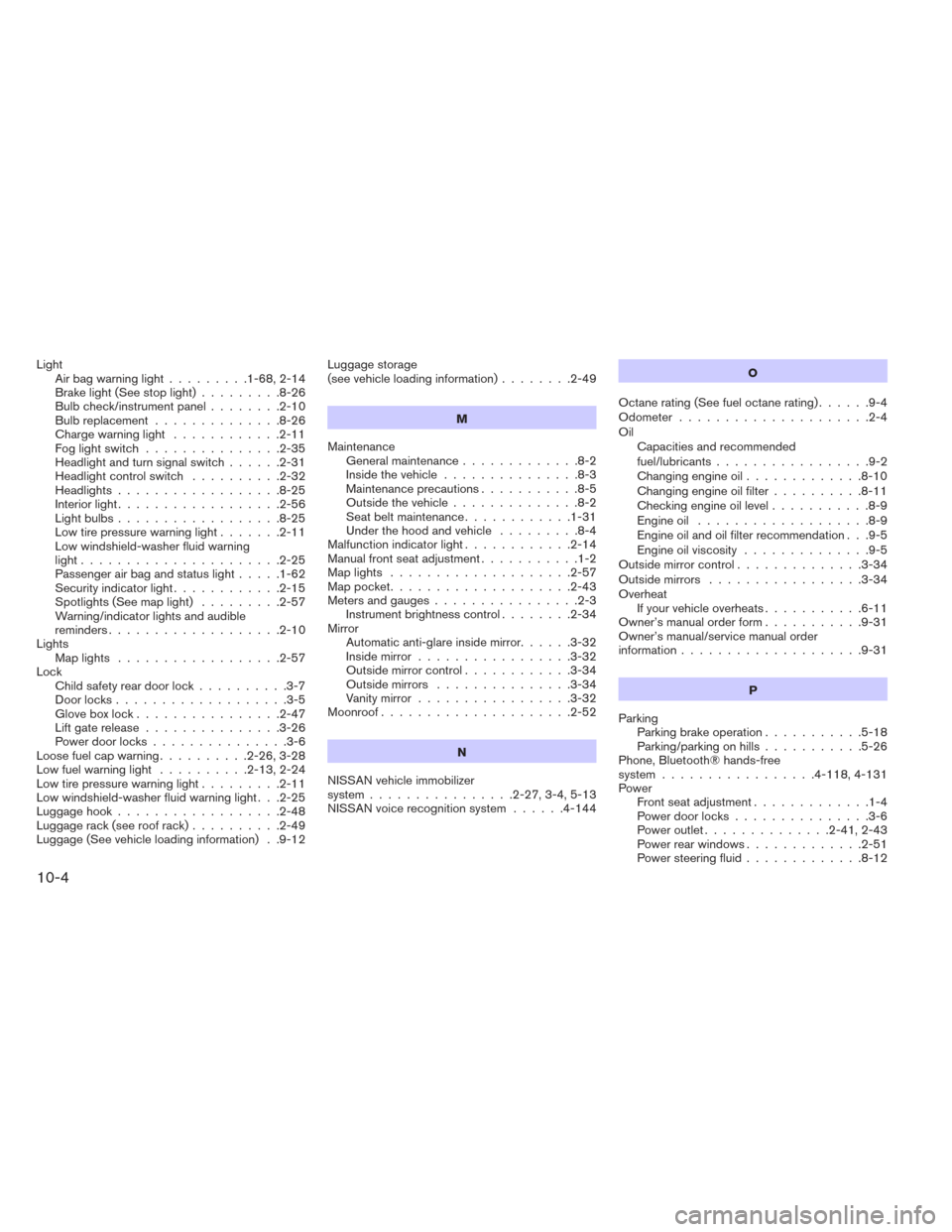
LightAirbagwarninglight.........1-68,2-14
Brakelight(Seestoplight).........8-26
Bulb check/instrument panel ........2-10
Bulb replacement ..............8-26
Chargewarninglight ............2-11
Foglightswitch ...............2-35
Headlight and turn signal switch ......2-31
Headlightcontrolswitch ..........2-32
Headlights..................8-25
Interiorlight..................2-56
Lightbulbs..................8-25
Low tire pressure warning light .......2-11
Low windshield-washer fluid warning
light......................2-25
Passenger air bag and status light .....1-62
Security indicator light ............2-15
Spotlights (See map light) .........2-57
Warning/indicator lights and audible
reminders ...................2-10
Lights Maplights ..................2-57
Lock Child safety rear door lock ..........3-7
Door locks ...................3-5
Gloveboxlock................2-47
Lift gate release ...............3-26
Power door locks ...............3-6
Loose fuel cap warning ..........2-26,3-28
Lowfuelwarninglight ..........2-13,2-24
Low tire pressure warning light .........2-11
Low windshield-washer fluid warning light . . .2-25
Luggage hook ..................2-48
Luggage rack (see roof rack) ..........2-49
Luggage (See vehicle loading information) . .9-12 Luggage storage
(see vehicle loading information)
........2-49
M
Maintenance Generalmaintenance.............8-2
Insidethevehicle...............8-3
Maintenance precautions ...........8-5
Outside the vehicle ..............8-2
Seatbeltmaintenance............1-31
Underthehoodandvehicle .........8-4
Malfunction indicator light ............2-14
Manual front seat adjustment ...........1-2
Maplights ....................2-57
Map pocket ....................2-43
Meters and gauges ................2-3
Instrument brightness control ........2-34
Mirror Automatic anti-glare inside mirror ......3-32
Inside mirror .................3-32
Outside mirror control ............3-34
Outside mirrors ...............3-34
Vanity mirror .................3-32
Moonroof .....................2-52
N
NISSAN vehicle immobilizer
system ................2-27,3-4,5-13
NISSAN voice recognition system ......4-144 O
Octane rating (See fuel octane rating) ......9-4
Odometer .....................2-4
Oil Capacities and recommended
fuel/lubricants .................9-2
Changing engine oil .............8-10
Changing engine oil filter ..........8-11
Checking engine oil level ...........8-9
Engine oil ...................8-9
Engine oil and oil filter recommendation . . .9-5
Engine oil viscosity ..............9-5
Outside mirror control ..............3-34
Outside mirrors .................3-34
Overheat If your vehicle overheats ...........
6-11
Owner’s manual order form ...........9-31
Owner’s manual/service manual order
information ....................9-31
P
Parking Parking brake operation ...........5-18
Parking/parking on hills ...........5-26
Phone, Bluetooth® hands-free
system .................4- 118, 4-131
Power Frontseatadjustment.............1-4
Power door locks ...............3-6
Power outlet ..............2-41,2-43
Power rear windows .............2-51
Power steering fluid .............8-12
10-4